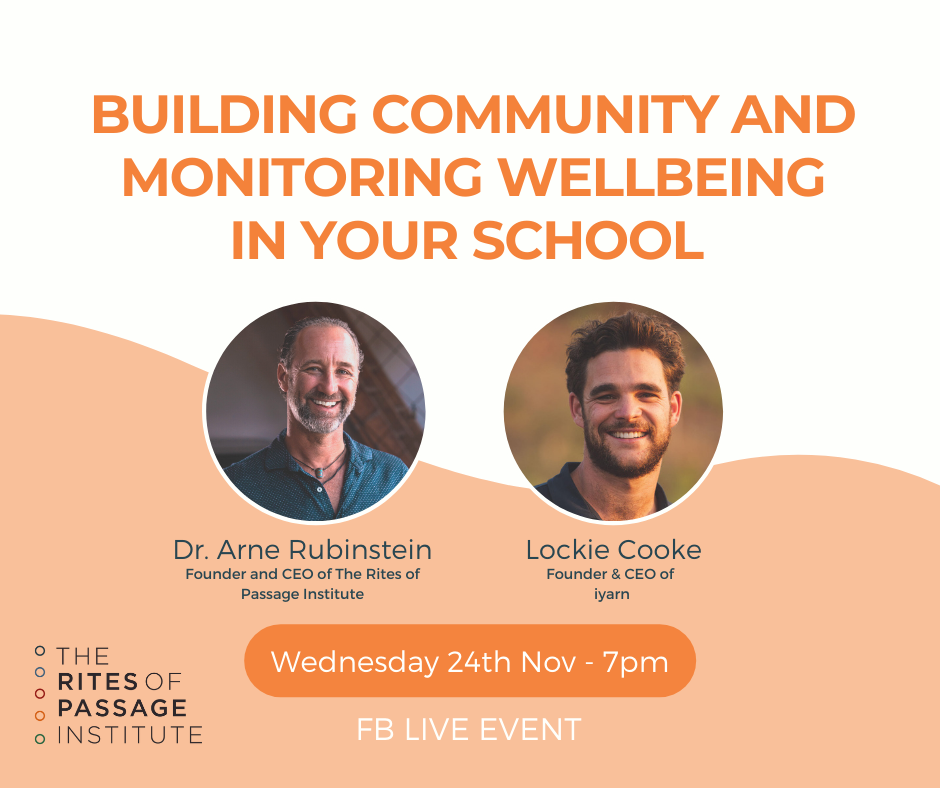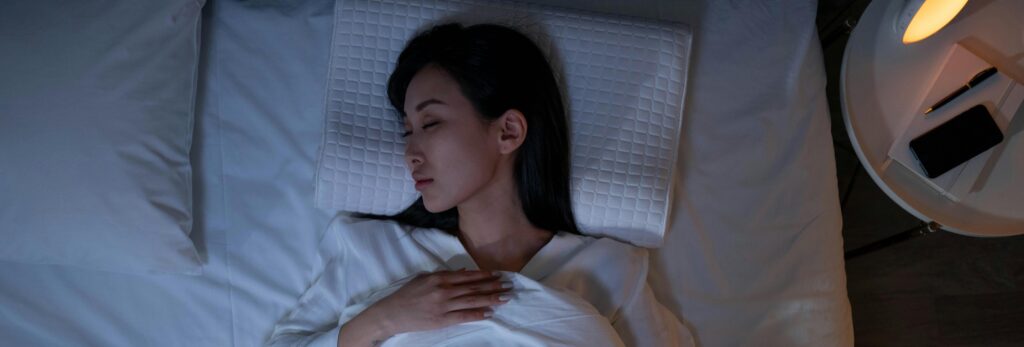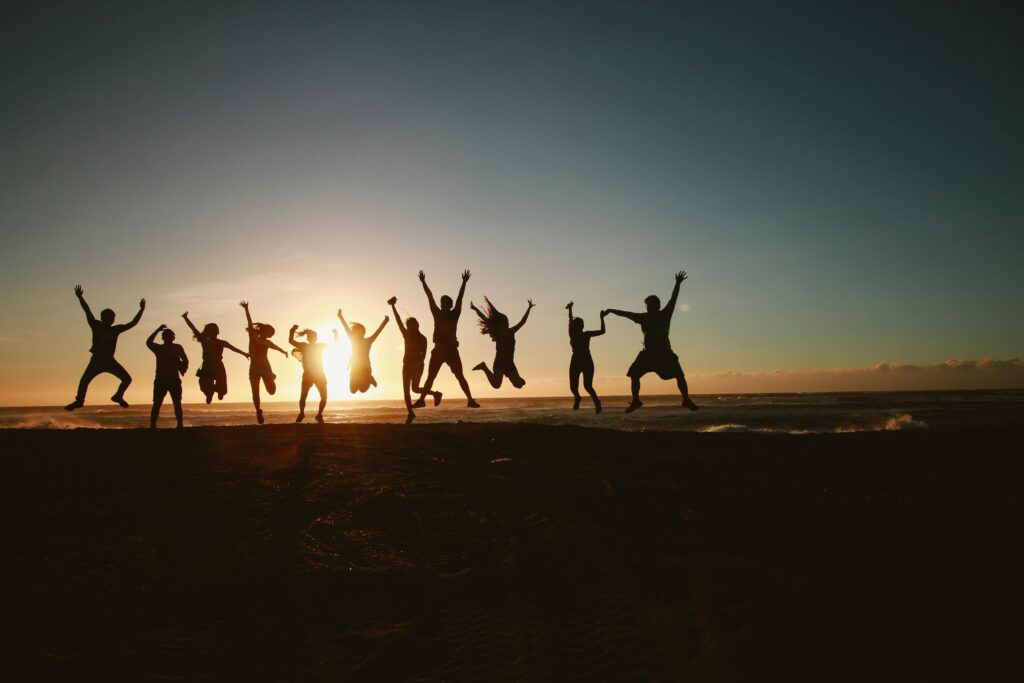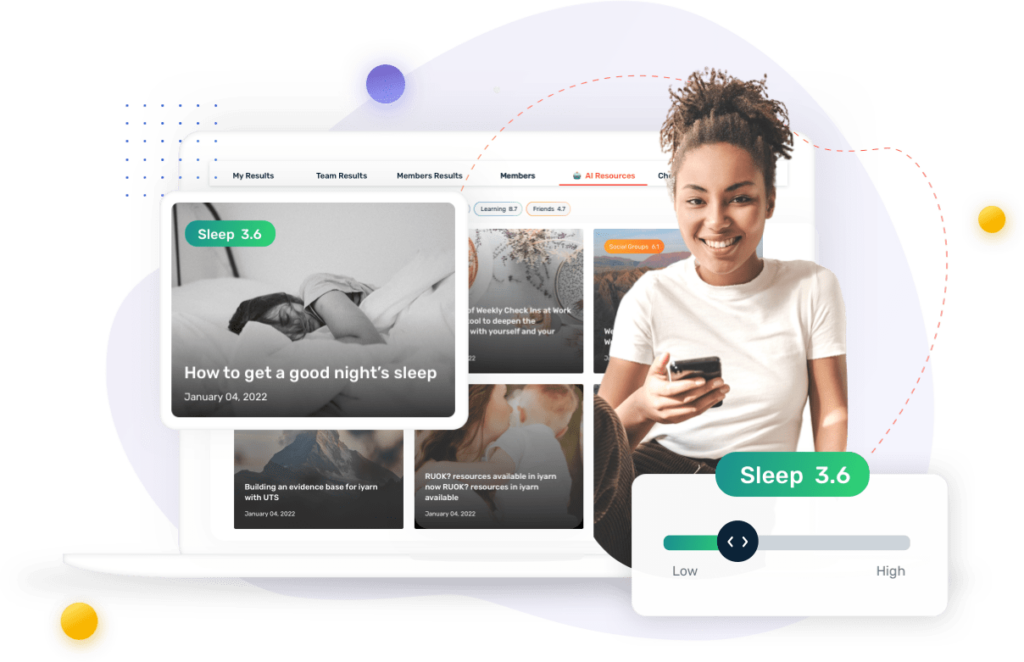Dr. Arne Rubinstein Interview: Building Healthy School Communities
Recently our CEO and Founder, Lockie Cooke, was interviewed by Arne Rubinstein to explore how to build healthy school communities and the critical role that iyarn plays in monitoring student wellbeing.
About Arne
Dr. Arne Rubinstein is a globally recognised expert on Rites of Passage, adolescent development, corporate leadership and transformational processes; with 30 years experience as a medical doctor, counsellor, mentor, speaker and workshop facilitator.
The programs, seminars and programs he’s helped to develop have been attended by over 250,000 people globally and are designed to support boys and girls to successfully make a safe, healthy transition to adulthood, with a particular focus on creating coming of age Rites of Passage.
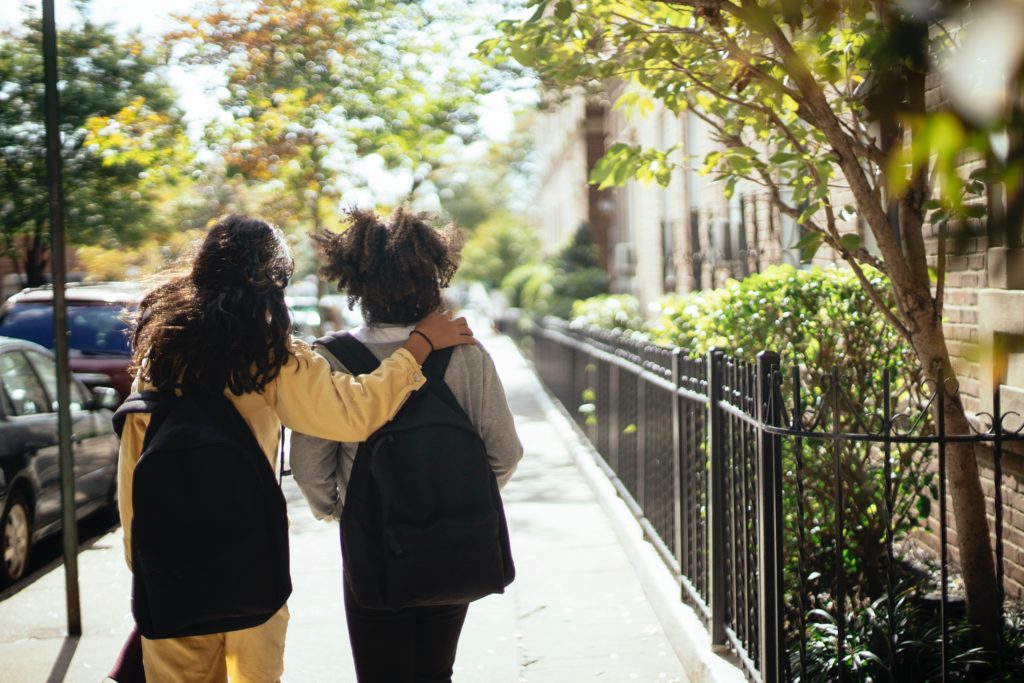
Building Healthy School Communities Across the Country with iyarn
Schools across Australia have found iyarn useful in facilitating conversations with their young people, identifying students at risk of disengagement behaviour and mental health struggles, and for student case management.
It’s common for schools to have over 2,000 students which makes it easy for at-risk students to go under the radar. iyarn creates a way simple for teachers, counsellors, or school psychologists to check in one-on-one with each individual student.
Good Practice for Using iyarn in Schools
Three practices emerged in the conversation between Lockie and Arne, drawing from their respective experiences working with schools across the country.
Collaborative Creation of the Check Ins
Many schools have found it good practice to create a generic wellbeing check in that they agree is appropriate, and then engaging the youth advisory council to co-create the check in questions for the year group.
Some groups go further, encouraging students to workshop the different words they want to use, how frequently they want to check in, what day of the week is best, and what is the best way for support, rather than using a traditional prescriptive approach.
This way of getting the kids enrolled in the journey is developing health social emotional wellbeing, meaning when they check in they’re creating more of a supportive community for their young people.
Designing the Check in Routine
Throughout Arne’s work with Rites of Passage, students have told him they want to have a voice on what’s going on and about decisions that are going to affect their lives. Allowing students to share their input on how often they get to check in and the questions and wording used is a really powerful step towards giving them cadence.
“We know that we have a lot of students who are under the radar especially with girls, it does seem that for boys and not always, these are generalisations, but when boys are acting out that’s a really good sign that there’s something going on that’s not okay. But with a lot of girls you know everything looks really good, they’re well presented, they do well in class, they’re polite, and all those things. We think ‘oh we don’t have to worry about her she’s doing really well’ but there are times when exactly girls like that are in fact enormously at risk, because internally they’ve got all sorts of stuff that they don’t tell anyone or no one knows about…
So any way that we can identify and be able to offer support to these students is so incredibly important, and you know a platform like iyarn can do exactly that.”
Arne Rubinstein
Consider Culture and Context
Culture is an essential consideration in the wellbeing of students. Culture can impact the types of check ins, the way that check ins are conducted and the resources that are required to support students.
iyarn has actively considered the role of culture and the need to be adaptable. For example, iyarn has been taken up in several remote indigenous communities, including Ardyaloon or One Arm Point. Other indigenous organisations are also using the platform to track the wellbeing of staff and service users.
These experiences have resulted in innovations that better serve diverse groups than a ‘one-size-fits-all’ platform.
Future Plans for iyarn
We’re now at a point where the Department of Education WA have seen the platform so we’re looking to roll out iyarn to a significantly large number more schools in 2022.
With each new adoption we’ve been able to build up our resources and tools through our psychologists and wellbeing experts. We’re now going into the next level by furthering our research base with the University of Technology Sydney.
We’re really great at creating safe spaces, providing data collection, and facilitating meaningful conversations but each school understands its own cultural needs, so this is where we empower schools to choose the support resources they want to have.
Watch the Full Interview Below to Learn More:
A lightly edited transcript is available at the bottom of this article.
Implementing iyarn in Your School
iyarn has been designed to support teachers, tutors and other mentors to manage student wellbeing. The platform provides an incredibly easy to use and secure way to check in on the topics that really matter to spark growth and connection.
If you’d like to talk further or schedule a demo of the platform, contact us for more.
or sign up to iyarn here app.iyarn.com
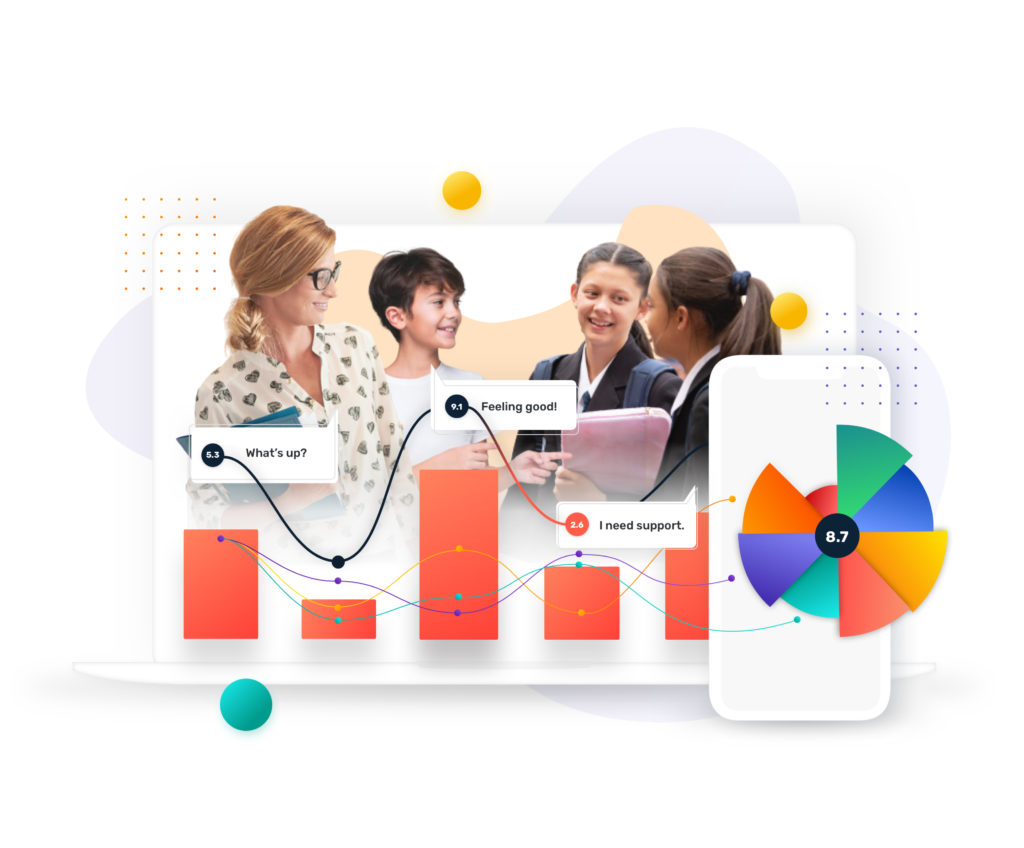
Interview Transcript:
37:09 Lockie: it also helps you show that you’re on a bit of a positive trend line and shows that you’re maybe growing that you can use the self sense of empowerment to show I’ve actually been you know a three out of ten before and then I went up to an eight and then I’ve gone down to three and out of ten again but I know I’ve come through that hard time and sometimes you know you forget about the hardship that you’ve been in the past and you’ve overcome it but as we know Arne with Rites of Passage work that’s part of life challenges and comes growth and it helps you have that roof the ability to reflect and have a number to it to show that that helps me build that resilience and I know that’s how a lot of teachers have found it useful to facilitating conversations with their young people.
Arne: And the tracking of it.. the ability to track it as you’re saying is so important, but you know I know we’re working indoors and where we are recommending to them these sorts of platforms for a number of reasons.
One is that whether we like it or not technology is the thing that the kids, the children, the students really interact with these days. That’s the reality and the other thing is you know some schools have got over 2,000 students these days, and it’s so easy for students to go below the radar, and they won’t necessarily talk, and they won’t necessarily share. But having a platform that can be offered to every single student in the year, in the school, and and then have a thing where a teacher or whatever can go ‘okay Wednesday morning nine o’clock everybody let’s do our our iyarn check-in’ and and if that can help us to identify the students who are at risk and red flagging is such, such an incredibly important thing.
Because one of the things that research shows us is that mental health is such a major issue, not only that, it’s increasing, the research shows in the last five years mental health issues have increased. And the early results coming out of Covid times is that Covid has just put it up a whole other level again. So we believe that Covid hasn’t actually caused the problems or the issues but has sort of magnified them.
And so, you know we know that we have a lot of students who are under the radar especially with girls, it does seem that for boys and not always, these are generalisations, but when boys are acting out that’s a really good sign that there’s something going on that’s not okay. But with a lot of girls you know everything looks really good, they’re well presented, they do well in class, they’re polite, and all those things. We think ‘oh we don’t have to worry about her she’s doing really well’ but there are times when exactly girls like that are in fact enormously at risk, because internally they’ve got all sorts of stuff that they don’t tell anyone or no one knows about. And if platforms like iyarn can pick up those issues and create the support for them, because the final thing is sorry, that we know students with mental health issues when they have a problem are still more likely to go to the internet than they are to go to a teacher, or a counselor, a psych who can genuinely support them. So any way that we can identify and be able to offer support to these students is so incredibly important, and you know a platform like iyarn can do exactly that.
But I have another question here, so let’s say year nine and I don’t know the answer, if we put together a wheel using iyarn and it’s got six, seven, or eight different spokes in it, can the students also put on it some of their own individual spokes so they can say ‘well actually I wanted, I know an area that I need to check in on is my relationship with a younger sister’ or you know whatever. Is that possible, Lockie?
Lockie: That’s what we really, we actually really encourage a lot of the young people in the schools we work with to do that, because it starts building up that you know value-based living concept around ‘you want to check in on the areas of life that matter to you’, and then you know you empower the kids to do that check in and that’s you know best practice.
That’s very personal and that is where the kid has the option to share it or not, because that’s private. You know that the way we set it up, is that some of that’s real confidential for the young person and maybe they don’t want to share that, but then we encourage.. What we find is best practice is that the school starts off with a bit of a generic wellbeing check-in that they agree that they believe is appropriate, and then the next level is like actually engaging the youth advisory council to co-create those check-in questions for the year group.
Arne: Fantastic, so you bring the students into creating their questions?
Lockie: Correct, and then the next level of that is actually when you have a year group yarn breakout session, workshop it with the kids come up with all the different words, and then the kids choose how frequently they want to do the check-in, how and what is the frequency, what day is the week is best, and what is the best way for support. So then it’s not this like traditional prescriptive approach ground – ‘this is a wellbeing tool, we want you to use this, use it, if you’re not using it you’re bad’. You know, it’s kind of actually get the kids enrolled and because we know that the kids care about wellbeing and mental health, and enroll them in the journey around this is developing healthy social emotional wellbeing, and when we check in we’re creating more of a supportive community for our young people.
But the one thing is where this can sometimes not get the same engagement is if we just use iyarn like a typical survey tool. ‘How are you going?’, you know ‘how are you going right now?’ and just kind of doing the generic questions out there and not really creating a space to have a yarn about that check-in. Because otherwise iyarn just gets put in the other basket as just being a generic survey tool, and the idea is that wheel that you have, we call it a conversation canvas, and then that can facilitate a meaningful yarn.
Arne: Yeah great, so I love hearing that, and we when we work in schools we go and we meet with the sort of senior staff, we meet with teachers, we also always meet with the students. We ask them what they want, and and one of the biggest things that they tell us is they want to have a voice. They want a voice in what’s going on, and they want a voice in decisions that are going to affect their lives. So the fact that hearing you say that
the students actually get input into how often they use iyarn, and what questions are used, and the wording that’s in those questions is really tremendous.
Lockie: I’ve just seen Ross’s question here as well Arne. Ross talking about the next level, about the specific student case management, students at risk of disengagement behavior, and mental health struggles. So this is a big thing where actually the school sites are using this as a one-on-one check in as well. Where they and what we do the high-risk young people who they have, they maybe choose a cadence. Is it a daily check-in? Or is it you know weekly or every other day? But then they co-create those segments one-to-one with that young person because again what we’re saying, they want to be enrolled and they want to be checking in the areas they want to check in on. So that’s been a really powerful way around how like school sites, chaplaincy services have been able to actually use this and councilors on a one-to-one case management place for sure.
Arne: Yeah great, and also what about the question around has it been taken up in any remote communities?
Lockie: Well yeah it’s been cool. iyarn has been tried in Ardyaloon One Arm Point Community Bardi people, this is one. I don’t know if you call it… it’s a regional town like Broome, we’ve got a few schools in Broome using it. We’ve also in Kununurra we’ve got you know Wunan which is who we’re starting to engage a lot more with or running a headspace up that way. Look at using it for youth engagement and tracking wellbeing of the young people, the Kimberley land council in Broome and their regional remote communities that they have influence in, over 180 of their employees, Langford Aboriginal Association, these are indigenous things. But, on a remote community level other than that, I’m just on the database I’d have to look back to it but I do see we’ve got quite far ranging in Central Australia and Queensland, we’ve got a few out that way as well.
Arne: Great, great and it’s interesting, so Ross Harold who’s been asking some great questions and we’re speaking to his school, and they have half of their students actually are remote learning. So something like 120 students from the school are you know living in remote areas and remote learning and you know it’s very hard to check in one-on-one with each of them but I can see how you know a tool like iyarn could be so incredibly useful in that sort of situation.
Lockie: On that question Arne it’s really interesting Lawrence Hargrave School which is a school for special needs kids in New South Wales, they were doing remote obviously with lockdown. A lot of the schools in New South Wales used iyarn for lockdown. So remote and Lawrence Hargrave every day they did a check in with all the students over Covid and the compliance was 100%.
This is something they did at the beginning of every day to just check in with the kids and that was really powerful to spark conversation with the young kids. So these are kids with complex needs, disabilities, and educate learning challenges so it was really powerful for them.
Arne: Now Lockie I imagine you see a lot of sort of the high level data that comes through iyarn, and I’m very interested to know from you what sort of… what are you seeing are the kind of the trends or issues you know, what would you say that you know we need to know about that’s going on for students at school these days that you’ve sort of discovered through iyarn?
Lockie: Yeah so what we’re able to do, we’ve got over like you know 700,000 different data points now and we can see on an aggregate level a bit of sentiment analysis, and what we can see is that schools are checking in on friends. Friends number one, sleep, and mental health are the three most common things that schools want to check in on young people on.
What that tells us is that you know they’re the big kind of ticket items from the majority of schools. You know, thousands of different data points and kids checking in on those segments. What that tells us is that mental health and well-being and sleep hygiene is a big thing that teachers care about, and students want to check in on. So what that tells us is that teachers need to be off talking and communicating about these things more, and if a teacher doesn’t not have that skill set we’ve got to engage the right people to talk about that and bring that awareness up because these are things that kids are checking in on and not necessarily flourishing at all the time. So it’s important-
Arne: You’re saying friends, sleep hygiene, wellbeing, and mental health. Is this what the school staff want to check in on or what the students want to check in on?
Lockie: This is what… they’re the most consistent segments that schools are using to check in on young people.
Arne: Yeah
Lockie: So when I say a school’s chosen these segments that could be because the young youth advisory council have chosen these segments, or could be more newer schools have said these are the segments we want to check in on. But, what we found is that they are the segments that are most frequently being checked in on and that is very aligned with all the data we see out there with say Positive Schools and Smiling Mindsand all the research out there is that these are the segments that people really want to check in on, and we need as educators, not myself but as teachers, who are using the tool what we are doing now, it’s really exciting to share this with you now Arne, is that we’ve just signed an agreement with University of Technology Sydney for a 12 month research project where we are further developing the evidence of research behind iyarn, and the corridor is developing better resources and support tools for teachers and students to have in those moments where they need more support.
Arne: Right, right.
Lockie: So this is yeah, it’s been a huge thing to just build up that evidence. There’s a lot of different platforms out there that don’t necessarily have that evidence behind it. We’ve got it already but we’re just further developing the resources, because what we found from Covid on is that it’s cool we’ve got this data but then what are we actually… how do I feel equipped to have those conversations with the young person? What is best practice? So where we’ve got tools that have been useful and developed through our psychologists and psychologist team and wellbeing experts, but we’re going in next level now and just getting a proper research base with UTS to go to the next level.
Arne: Well done, well done. That’s a fantastic thing. I’m interested in what you said about the sleep hygiene, I heard some research a while ago now that young people need something like eight and a half to nine hours sleep a night but since the introduction of mobile phones they’re getting on average six and three quarter hours, because you know they’re there phone under the blankets or they got the phone next to their bed and pings in the middle of the night from one of their 2,000 friends that they absolutely have to speak to. So yeah that’s a big thing.
Lockie: Huge, totally Arne, and I’ve just seen a few questions come here with Ryan and Ross which talks about support to schools in building capacity of staff and many of you are, so yeah we offer PD sessions and schools go out there whether it’s virtually on the zoom call: how to facilitate conversations, how to create a wheel, how to engage with youth advisory councils, how to you know all these different things. We’re also… and then this other one around culturally relevant resources for Indigenous communities.
What we find is that iyarn, we’re really great at creating safe spaces and data collection and and facilitating meaningful conversations but you as a school you understand your own cultural needs, so this is where we empower you to choose the support resources you want to have. We’ve got a bunch of resources we could suggest that are useful but then this is where you can kind of lead into your cultural nuance and add that spark so when I say ‘do you have Indigenous cultural relevant resources?’, yes we do, but then we kind of if that’s the case we kind of lean in with that Indigenous liaison officer, Indigenous employee, Indigenous team member to make sure and just workshop some of those things that make sure it’s really aligned with what we’re about and culturally appropriate.
Arne: Yeah and I guess why I’m so interested in iyarn and what you’re doing is because our work which is Rites of Passage but now extends to what we call transformational education out within schools, building healthy communities, teaching critical 21st century life skills and creating healthy rites of passage, and you know a platform like iyarn really gives us an opportunity to monitor how well our work is actually impacting within the school. Are we improving the culture of the community? Are they learning the life skills that they really need, and are the rites of passage that they’re going through having a healthy impact on them rather than being you know wounding and traumatic and creating problems?
So I can just see that there are so many different environments where iyarn could be used, and Lockie how many schools are you in these days? Like after when you started this I remember when you were “Arne, Arne, I want to tell you about this thing I’m developing!” and where are we up to Lockie?
Lockie: Yeah so it’s been wild how just in the last you know we’ve been working the first couple years trying to get those testimonials and traction and things like that, but currently we’re in in some form of trial in over 100 schools across the country, and then we’ve got a number of schools have adopted across the whole school environment, so that’s all like 1,300 students when I say a number we’re talking about 15, and then we’ve got another 40 schools who are using across different year groups. So we’ve got like where they say all the year 8’s, all the year 10’s are using it but we haven’t rolled out across the whole school ecosystem.
So you know it’s really exciting, but we’ve kind of at the point now where you know the Department of Education WA have seen it, they see the impact it has and they really want to actually support it into more schools. So we’re at a point now where we’re starting to roll out to a significantly large number more for 2022. So we’re you know, if you say the golden check in, what do I need help with at the moment? It’s about finding more people who can help us go into more schools and create these spaces to do it. We’ve got a great team behind us so you can help facilitate it into your schools and we’ve got some really great partnerships of people who have been education experts the Fogarty Foundations, School Plus, the AIS with their community outreach programs. We’re starting to collaborate a lot with with our outreach, so sometimes we’re getting you know the plan is 2022 we’ve got a bunch of athletes going out and actually facilitating these sessions in schools as well. So really exciting time for us and as we ramp up into 2022.
Arne: Fantastic, if people want to find out more about iyarn Lockie, what do they do?
Lockie: A great way… I’m sure there’s been a bunch of people signing up today or who are listening to the recording you go to iyarn so iyarn.com.au, you can you know see what it’s about, schools page, we’ve got you can sign up there for a bit of a free trial so it just gives you free basic access. Feel free to do that with your school email. You can reach out to me if anyone’s here, Lockie@iyarn.com.au.
Generally I love connecting with people and like-minded people tuning into this session, so I’d love to have a session, a yarn, and see if this could meet the needs of you, you know we’re not prescriptive around how your school signs up. We’ve got a few ways around how schools have really embraced iyarn and implemented at best practice but we understand each school is different, so we can have a conversation and kind of understand what your needs are. The price of iyarn’s very affordable you know, it’s about eight hundred dollars per year group for the year of up to 200 students, and about five thousand dollars for a whole school environment so it’s not a crazy expensive tool. It’s affordable and it can really get the insights but also mitigate some real challenges and overcome some challenges early on as primary prevention the young kids face in school environments.
Arne: Brilliant Lockie brilliant thank you, and I want to finish tonight by just honoring you for who you are and what you’re doing. I don’t know exactly how long it was ago that I met you but it’d have to be six years or so, something like that, and these things were kind of ideas for you and you know I just love seeing the way you’ve had a vision to do something, you’ve created it, you’ve made it successful, you’re getting it out there, you’re making a difference, but then hearing your story. You know hearing your connection and what happened to your school, and your connection with Indigenous communities and the work that you’ve done there over the years, and also now seeing you as a young father with Harvey and everything that involves. I’m really proud of you Lockie, and I loved interviewing you tonight and thank you for being you.
Lockie: Thank you Arne, means a lot mate I really do appreciate that for taking that in, thank you.
